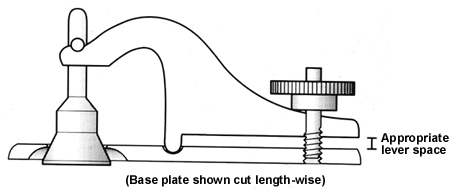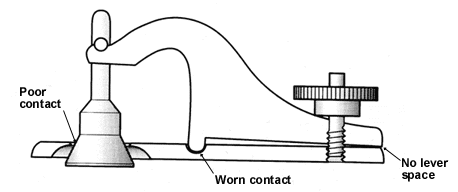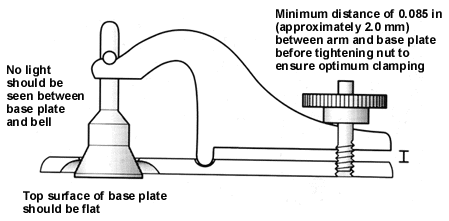
Am Fam Physician. 1999;59(10):2724-2732
to the editor: We enjoyed the recent article, “The Gomco Circumcision: Common Problems and Solutions,” by Drs. Peleg and Steiner.1 In this excellent review of the complications of Gomco circumcision, the authors discuss the indications, contraindications and proper technique for performing Gomco circumcision.
It is noteworthy, however, that Drs. Peleg and Steiner fail to mention the most effective anesthetic technique for circumcision, the ring block. In a recent randomized, controlled, prospective study,2 researchers compared the efficacy of ring block, dorsal penile nerve block, topical eutectic mixture of local anesthetics and topical placebo during neonatal circumcision. Based on the infants' crying and heart rate during the procedure, the most effective anesthetic in relieving the discomfort of circumcision was shown to be ring block.
Family physicians who perform neonatal circumcision may reduce discomfort during the procedure by incorporating the ring block as their anesthesia technique of choice.
to the editor: In their article, “The Gomco Circumcision: Common Problems and Solutions,”1 Drs. Peleg and Steiner present a good review of the technique and some of the common issues that arise when performing this procedure. Omitted, however, is mention of a not infrequent complication: degloving of the penile shaft skin.
Degloving may occur after a circumcision is performed using a Gomco clamp that is too large, or after too much foreskin is pulled through the bevel hole. After the clamp and bell are removed, the shaft skin is noted to retract, exposing the underlying tissue proximal to the coronal sulcus. This complication may be seen immediately or identified several hours later, after continued bleeding.
Attempts to control the bleeding with the application of Gelfoam usually fail. A primary closure is a better solution and is easily accomplished. Four absorbable sutures (5-0 chromic) are placed circumferentially to reposition the retracted shaft skin to a point just proximal to the corona. Care must be taken to avoid the urethra, which lies in the ventral midline. Some physicians catheterize the infant with a 5F feeding tube before performing the repair. No special aftercare, other than the usual post-circumcision application of petroleum jelly or antibiotic ointment, is needed.
The authors also mention that the Gomco clamp should not be used if the infant's penis is less than 1 cm in length. In such a case, the use of a Mogen clamp may be considered.
At our institution, family physicians routinely perform circumcision of infants who are ready for discharge from the neonatal intensive care unit. In such cases, we consider the reason that the baby required intensive care and decide if circumcision is an appropriate procedure for him at that time. Arbitrarily, we usually prefer that the baby weigh at least 2,500 g (5 lb, 9 oz) and be less than 30 days old; otherwise, we recommend outpatient circumcision at a later time.
to the editor: I read with interest the article by Drs. Peleg and Steiner on the common problems and solutions of Gomco circumcision. The article was useful and timely in light of the ongoing controversy regarding the “best” method of circumcision, and the pros and cons of each technique.
One of the more common complaints I hear about with regard to the Gomco device is the potential for bleeding complications. In an effort to decrease the frequency of these complications, I offer the following reminder: in addition to checking “to make sure the bell is the right size for the clamp and that there are no defects,”1 also check for abnormal wear of the base plate or the rocker arm. I have noted on several occasions, at different institutions, that either or both of these portions of the clamp can be excessively worn, resulting in inappropriately low lever action on the bell. When this is the case, pressure may be insufficient to ensure full hemostasis of the newly cut foreskin edge.
Before the circumcision procedure is performed, the Gomco device should be fully assembled and have an appropriate “lever space” (Figure 1). If insufficient lever space is noted (Figure 2), a different lever arm and/or base plate should be requested and checked for adequacy. Worn equipment should be replaced to avoid unintentional use in future circumcisions.


to the editor: The article by Drs. Peleg and Steiner1 on the problems and solutions of Gomco circumcision fails to mention the surest solution: not to perform circumcision at all. The Canadian Pediatric Society does not advocate circumcision, and many Canadian provinces no longer pay for the procedure.2 The state of Oregon does not cover this procedure under its health care plan.
Most of the world's men are not circumcised, and they continue to fare well. Routine neonatal circumcision is as ingrained in modern American society as routine pediatric tonsillectomy and adenoidectomy were 50 years ago. The article does show that what is often assumed to be a safe, risk-free procedure is laden with numerous mentioned (and unmentioned) complications. Aside from this, however, the article only contributes to our ignorant attitude toward circumcision.
to the editor: In reference to the excellent article on Gomco circumcision by Drs. Peleg and Steiner,1 it might be added that another method of circumcision is available, involving use of the Plastibell device (manufactured by the Hollister Corporation of Chicago, Ill.).
During my residency training, our hospital had a great system for performing circumcision: one family medicine resident performed all newborn circumcisions for one month at a time. This afforded each resident significant experience in performing circumcisions, using various techniques. The techniques used were those that were preferred by the attending physician; thus, each resident was given a chance for varied instruction, learning and experience.
Having used the various circumcision techniques as a resident, I favored the Plastibell technique because it is simpler than the Gomco technique and has very few complications. This is particularly true with regard to postoperative bleeding. Probably the best reason for choosing the Plastibell technique is that no aftercare is required by the parent, and the baby can be bathed as soon as the parent wishes.
These comments are not meant to detract from the Gomco procedure; it is a time-honored and effective technique. However, I believe the Plastibell technique has some advantages of which we should be aware. It has been 30 years since my residency training, and I still prefer using the Plastibell technique over other circumcision methods.
in reply: Drs. Johnson and Clenney are correct that we do not cite the ring block technique in our article, “The Gomco Circumcision: Common Problems and Solutions.”1 When the article that they cite was published in the Journal of the American Medical Association (December 24, 1997),2 our article had already been submitted for publication. Although we also briefly discuss a topical eutectic mixture of local anesthetics in our article, the article is limited in scope to discussion of dorsal penile nerve block. This focus reflects the fact that the bulk of the literature regarding anesthesia for neonatal circumcision concerns dorsal penile nerve block.
The dorsal penile nerve block is the most widely used technique and the one for which the most information on safety is available. Other methods of local anesthesia that are not discussed in our article include the technique described by Masciello,3 the use of topical lidocaine cream, both 30 percent4 and 4 percent,5 and methods of analgesia such as oral sucrose as a 12 percent solution6 and in a sucrose pacifier.7 We chose not to discuss methods of post-procedure analgesia.
Dr. Greenberg makes several interesting points in his letter. First, he mentions the complication of degloving of the penile shaft skin. In a review of 5,882 circumcisions,8 the authors commented on three cases of denudation of the penile shaft. In two of these patients, the skin loss was partial, and the involved area was reepithelialized without specific treatment. In the third patient, the entire penile shaft was denuded and treated with burial of the penis in a tunnel of scrotal skin; however, the patient was lost to further follow-up.
In our experience, this complication has fortunately been rare, has always been partial, has not required additional surgery and ultimately has had a good cosmetic result. Dr Greenberg's suggestion for selection of a Mogen clamp for circumcision of a short penile shaft is appropriate. We agree with his criteria for the selection of infants for circumcision who are being discharged from the neonatal intensive care unit.
Dr. Hinterberger makes an excellent point regarding the assessment of the Gomco clamp before initiation of the circumcision procedure. The manufacturer states that the assembled clamp must be inspected before each use to ensure that the plate is flat, that no light can be seen between the bell and plate and that at least 0.085 in (approximately 2.0 mm) of clearance is present between the arm and the plate at the screw9 (Figure 1).

Dr. Honsinger makes a point that the practice of newborn circumcision is controversial. Issues such as ethics, sexual function, aesthetics, medical and psychologic implications, culture and cost-effectiveness have been debated. Our charge in writing the review article was to touch on some of the common problems that are associated with Gomco circumcision and the solutions to these problems. This purpose is a valid one since circumcision is widely practiced by the readership of American Family Physician. It is certainly reasonable that AFP would want to address this debate in the future.
Dr. Guazzo raises the point that the Plastibell device is an alternative to the Gomco clamp. In a study8 comparing complications of the Gomco clamp technique and the Plastibell technique, the rates of bleeding were slightly higher in the Plastibell group. In addition, the Plastibell group had a higher rate of infection.
Dr. Guazzo writes that a good reason for using the Plastibell is that “no aftercare is required by the parent, and the baby can be bathed as soon as the parent wishes.” We find that parents like to take their baby home with the circumcision procedure completed and without the “hardware.” Some parents who have previous knowledge of the Plastibell technique have even requested that this technique not be used. We do not restrict bathing after circumcision using the Gomco technique. Certainly, though, the Plastibell technique is a reasonable choice for performing newborn circumcision.